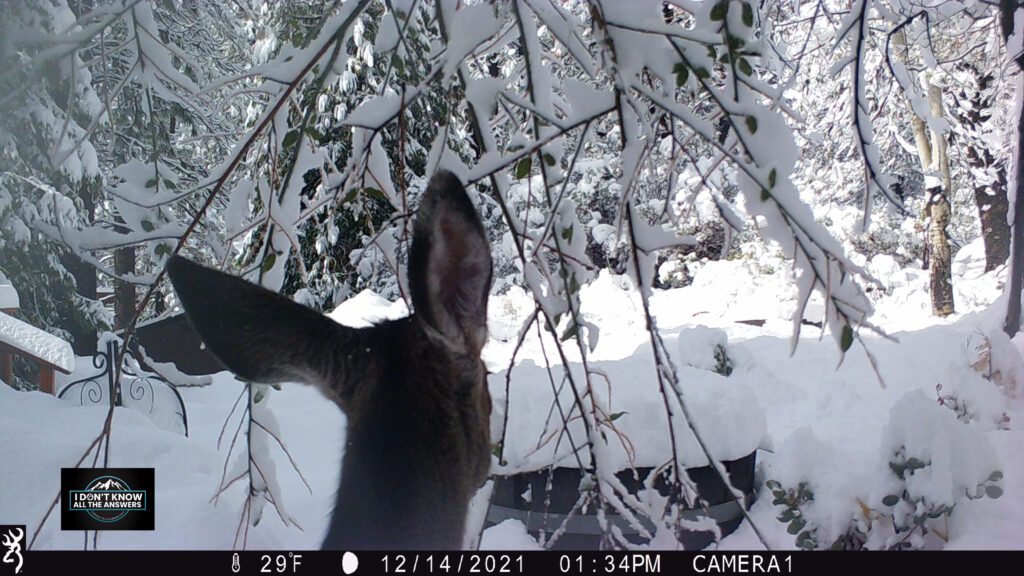As I reflect on the enchanting wildlife that graced me with their presence during my time in the Sierras, the image of the beautiful black-tailed deer that visited me every day stands out. With their sleek and elegant bodies adorned with their distinct characteristic tail, watching them move gracefully across the landscape was a treat. Every morning, I would eagerly await their arrival, my heart filled with joy as they delicately nibbled on the surrounding vegetation. Witnessing these magnificent creatures in their natural habitat was a true privilege, and their daily visits were undoubtedly one of the highlights of my time spent amongst the magical wildlife of the Sierras. Winter is approaching, and I am thinking about the deer families.
Winter in the Sierras can be unforgiving, especially for wildlife that must brave the elements to survive. While some migrate to warmer areas, others, like the black-tailed mule deer, adapt to the environment and make the best of the situation. But how do these creatures manage to pull off this feat? What are the secrets to their survival in such a challenging environment? This post will explore how the black-tailed mule deer prepares for and survives the harsh Winter in the Sierras.

1) The Science of Winter Preparation: Dealing with Food Scarcity
Food scarcity is one of the biggest challenges the black-tailed mule deer faces in the Sierras during Winter. Winter weather conditions hamper plants’ growth, and as Winter progresses, the deer have to cope with vegetation struggling to survive. Their response is to stockpile food during the months leading to Winter when food is still relatively abundant. The deer consume copious amounts of plant matter, especially high-carbohydrate sources like acorns and nuts, which they use to build up their fat reserves to stay warm during the colder months.
2) Thick Hides and Camouflage: Protection from the Elements and Predators
Another survival mechanism the black-tailed mule deer has developed is its unique fur coat. The black-tailed mule deer has a layered coat of fur, starting with a soft and insulating underlayer and covering it with shorter, water-resistant guard hairs. These combined layers help keep the deer warm and dry during Winter, even in cold temperatures and snow. Additionally, the deer’s fur patterns camouflage them from predators, making it difficult for predators to spot them in the snowy landscape.
3) Energy Conservation: The Need to Conserve Energy
Deer are also great at conserving energy during Winter. They spend considerable time far from their regular daytime stomping grounds, preferring to rest during the daylight hours or late evening. They tend to move around more frequently at night or early dawn hours, only when temperatures aren’t too cold, enabling them to stay warm effectively without expending too much energy. When active, they move cautiously and avoid sudden movements that could deplete their fat reserves.

4) Water Sources: Seeking Out Water Sources in the Winter
Water is another essential factor that deer must consider when getting ready for the winter month. While many creeks and streams become very shallow during Winter, other water sources dry up. The black-tailed mule deer keeps an eye on the locations of water sources and is cautious about exposing themselves during drinking. They also get a portion of their water from the vegetation they munch along the way.
5) Teamwork: Staying with the Herd
During Winter, deer herds grow in numbers to stay close to each other to conserve warmth. The deer remain within a herd to reap the reward of each other’s heat, making it easier than being alone with prolonged exposure to the elements. Deer also use communication techniques like snorts, bleats, and even body language to help each other stay alert and identify threats.
The black-tailed mule deer’s survival in the Sierra winter is remarkable. Through food scavenging, intelligent energy management, and keen predator avoidance skills, the deer has existed and thrived even in tough times. They also use water sources, group themselves into big numbers, and wear natural camouflage to help them stay hidden and take precautions from wandering predators. As awe-inspiring as it is, the black-tailed mule deer’s story also underlines the resilience of nature and the ingenious ways creatures can respond to adversity.
Thank you for reading this blog post, and if you have any questions or comments, please leave them in the Comments section below.
Copyright © 2019. I Don’t Know All The Answers®, Nikki Mastro.
All of my photographs and documents are Copyrighted.
No part of this website, including text, photographs, and documents, may be reproduced, stored in a retrieval system, or transmitted in any form or by any means without written permission from the copyright holder. All unauthorized use is strictly prohibited. If you choose to copy or share any information from my site, you must provide a link to the source. I appreciate your cooperation.
For further information concerning “I Don’t Know All The Answers®.”
– Blog: https://www.idontknowalltheanswers.com
– Facebook: https://www.facebook.com/Nikki.L.Mastro
– Instagram: https://www.instagram.com/i_dont_know_all_the_answers/
– Youtube Channel: https://www.youtube.com/@idontknowalltheanswers1954

